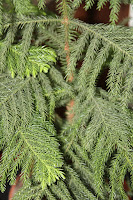Norfolk Island Pine Tree tabletop holiday decor
 Captain Hook landed on Norfolk Island around 1772 and was impressed by the 100-foot tall evergreens that populated the coastline. When he sent specimens back to England, botanists gave them the Latin name of Araucaria excelsa heterophylla but their common name has always been Norfolk Island Pine.
Captain Hook landed on Norfolk Island around 1772 and was impressed by the 100-foot tall evergreens that populated the coastline. When he sent specimens back to England, botanists gave them the Latin name of Araucaria excelsa heterophylla but their common name has always been Norfolk Island Pine.The little Norfolk Island trees we grow as houseplants are actually slow-growing seedlings. They are not pine trees but acquired the name because they resemble pines. In Camarillo CA where they can grow outside all year, one tree measures 109 feet tall with a 65-wide crown. In our zone 7 weather they are grown in containers and brought inside before freezing temperatures arrive in early winter.
We keep our Norfolk Island Pine on the back porch in the summer where it receives bright, filtered light, then it comes inside for the winter where it doubles as a holiday tree decorated with tiny angels. It is an easy plant to take care of since it needs no pruning, but it does require bright light, regular water and fertilizer such as 9-3-6.
Half of the expert advice about Norfolk Pine says to mist them since their native habitat is a misty seaside but the other half say to never mist them or the tree will get scale and spider mites. The same is true of pruning advice: some recommend pruning and others say to never prune. Our tree is watered regularly but has never been misted or pruned.
As with many other houseplants, Norfolk Island Pine trees are fertilized during the growing season rather than year round. In the wild, they grow in rocky, sandy, slightly acid soil so when planting and re-potting give them soil with plenty of drainage by adding perlite or sand to your regular potting soil.
There are 18 species of evergreen, coniferous trees in the Araucaria genus. They are from zones 9-11 in tropical rainforests that have a dry season, including New Guinea, Australia and Brazil. Norfolk Pine can be grown from seed and cuttings.



Comments